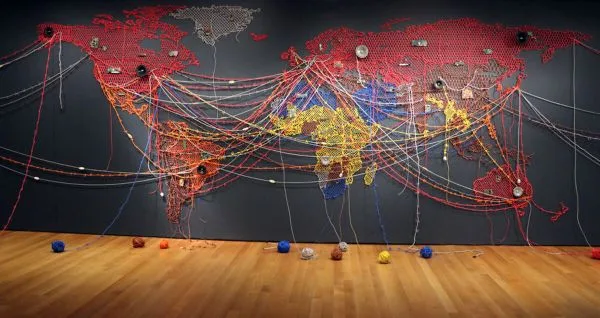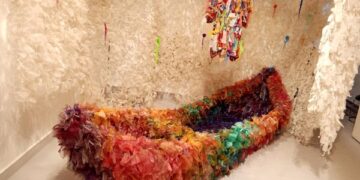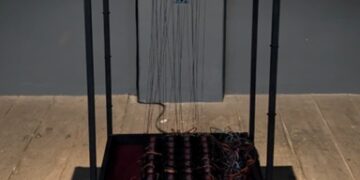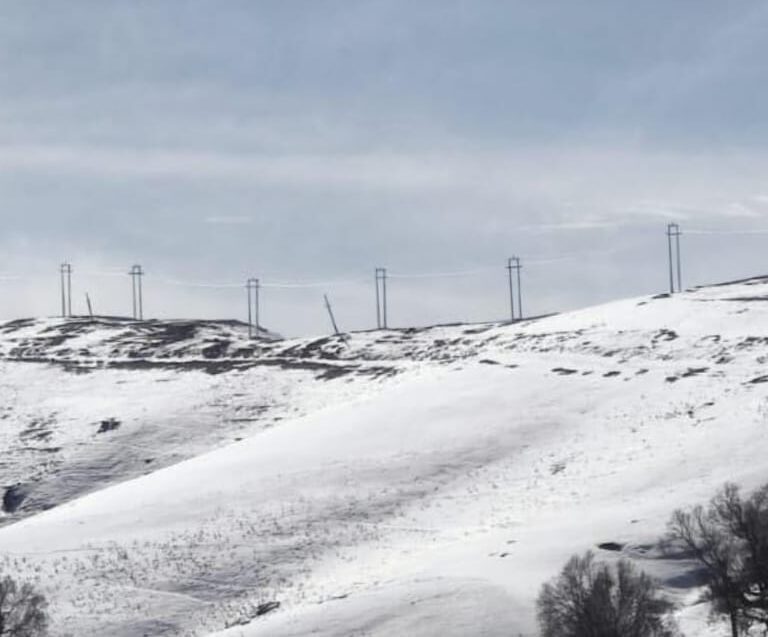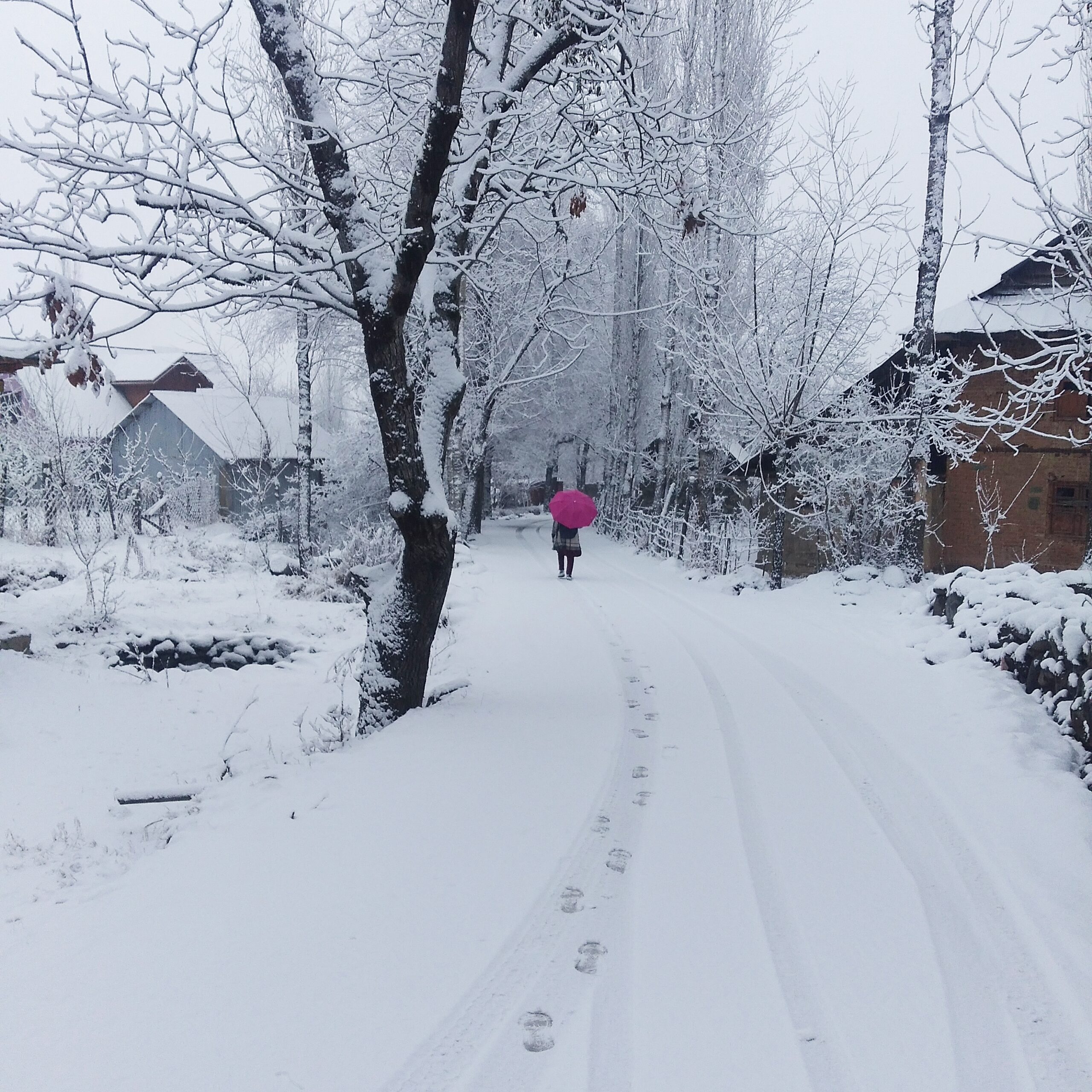In a softly lit gallery space, a wall stands covered not in canvas or paint, but in a web of knotted wires. From a distance, it resembles a world map—familiar outlines of countries and continents laid out in careful proportion. But as you approach, the materials begin to speak louder than the shapes they form. These are electric cables, barbed and tangled, wound together to trace the borders that divide the globe. The installation crackles—not with actual current, but with the tense energy of conflict, memory, and control. This is the haunting world of Reena Saini Kallat, one of the most compelling artists working in Indian contemporary art today.
Kallat’s electric wire maps aren’t maps in the usual sense. They don’t help you find your way. If anything, they’re designed to make you pause, disoriented, and rethink how we even define place, nationhood, and connection. In an age of barbed rhetoric and rising borders, her maps are both mirror and metaphor. They show us the world not as it should be—but as it too often is: bound by restriction, surveillance, and separation.
Born in 1973 in New Delhi and based in Mumbai, Kallat has built a reputation for work which is both conceptually rigorous and emotionally stirring. A graduate of the Sir J.J. School of Art, her practice has grown over last two decades to include sculpture, installation, photography, drawing, and video. But no matter the medium, her art consistently returns to themes of identity, migration, memory, and the bureaucratic machinery that governs lives.
The electric wire maps are among her most recognized bodies of work. These installations—some small and intimate, others sprawling across entire gallery walls—are meticulously constructed from coiled electric wires shaped into the outlines of political maps. Some are based on existing borders. Others imagine alternative, historical, or disrupted versions of the world. In each case, the materiality is essential. Wires, especially when knotted and barbed, carry complex associations: they conduct energy but also restrict; they connect but also fence off.
This duality is central to Kallat’s project. Her maps are not passive representations—they are emotionally and politically charged fields. In many works, the wires used resemble barbed fencing, a deliberate nod to the reality of heavily patrolled borders and the harsh physical measures used to define territory. And yet, these same wires are also the stuff of connectivity—used to transmit voices, power cities, link lives. Kallat exploits this contradiction to full effect, forcing us to confront the absurdity of lines that simultaneously bind and divide us.
In one of her most well-known installations, “Woven Chronicle”, she charts the migration patterns of workers across countries and continents using tangled cords affixed to the wall. Alongside the visual representation is a subtle but powerful soundscape: audio recordings of ports, trains, factory machinery, and indistinct human voices play softly through embedded speakers. The effect is immersive and deeply moving. What could have been a dry geography lesson becomes a poetic meditation on movement, displacement, and labor.
The beauty of Kallat’s work lies in how it invites, rather than instructs. There are no slogans, no didactic labels. Her maps don’t tell you what to think. Instead, they ask you to feel the discomfort of a world carved up by politics. They prompt you to question the assumptions we make about permanence and belonging. In a world where nationalist ideologies increasingly dominate political conversations, her installations ask a quiet but profound question: What happens to humanity when we value borders more than the people who cross them?
Kallat has often spoken about her interest in “the tension between systems of division and structures of connectivity.” In addition to electric wires, she has used rubber stamps, salt, and even official seals in earlier works—materials tied to state power and bureaucracy. The electric wires in her maps are an evolution of this inquiry, reimagining the very tools of control as potential conduits for understanding and reflection.
In some iterations, her wire maps focus on specific contested regions: the India-Pakistan border, for instance, or the Israel-Palestine divide. In others, she abstracts the entire globe, blurring boundaries to suggest how arbitrary and shifting they really are. Her map of the world drawn entirely from bleeding ink lines—“Leaking Lines”—is a powerful extension of the same idea, visualizing geopolitical wounds as literal stains on paper.
What makes Kallat’s work particularly relevant is how it speaks to a global condition without losing its specificity. Her voice is unmistakably Indian, rooted in the complexities of South Asian history and post-Partition trauma. Yet her concerns are universal: migration, exile, identity, surveillance, freedom. The electric wire maps resonate whether viewed in New York, Tokyo, Berlin, or Bengaluru.
In interviews, Kallat often reflects on how we carry “personal memory alongside public history.” This is especially evident in her maps, where the coldness of cartographic outlines is warmed—and wounded—by the emotional weight of migration stories. For many who see her work, especially those from diasporic or displaced communities, it strikes a deeply personal chord. The wires, though silent, seem to echo familiar feelings of rupture, longing, and resilience.
Critics have praised her for the elegance and depth of her installations. Her work has been exhibited at leading venues around the world, including the Tate Modern, the Museum of Modern Art (MoMA), the Mori Art Museum in Tokyo, and the Kochi-Muziris Biennale. Yet despite her international acclaim, Kallat’s art remains resolutely grounded. It doesn’t aim to shock or provoke for its own sake. Instead, it insists on a quiet, necessary empathy.
At a time when the world feels increasingly fragmented—by politics, by ideology, by fear—Reena Saini Kallat’s maps do something radical: they ask us to imagine a different way of seeing. One in which the lines that divide might one day become the paths that connect. Her wires, after all, are not fixed. They can be bent, rewoven, rerouted. Like history, they can be reimagined.

